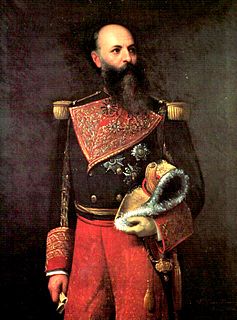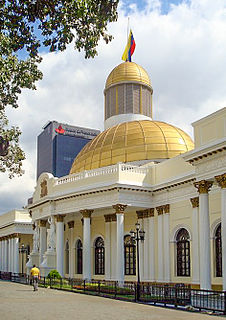
Sir Charles BarryFRS RA was an English architect, best known for his role in the rebuilding of the Palace of Westminster in London during the mid-19th century, but also responsible for numerous other buildings and gardens. He is known for his major contribution to the use of Italianate architecture in Britain, especially the use of the Palazzo as basis for the design of country houses, city mansions and public buildings. He also developed the Italian Renaissance garden style for the many gardens he designed around country houses.

Antonio José Ramón de La Trinidad y María Guzmán Blanco was a Venezuelan military leader, statesman, diplomat and politician. He was President of Venezuela for three separate terms, from 1870 until 1877, from 1879 until 1884, and from 1886 until 1887 And General during the Venezuelan Federal War.
The year 1907 in architecture involved some significant architectural events and new buildings.
The year 1874 in architecture involved some significant architectural events and new buildings.

Martín Tovar y Tovar was a Venezuelan painter, best known for his portraits and historical scenes.

The Central University of Venezuela is a public university of Venezuela located in Caracas. It is widely held to be the highest ranking institution in the country, and it also ranks 18th in Latin America. Founded in 1721, it is the oldest university in Venezuela and one of the oldest in the Western Hemisphere.

Frederick Marrable was a British architect who was notable as the first Chief Architect for the Metropolitan Board of Works, responsible for designing its headquarters.
Thomas Garner (1839–1906) was one of the leading English Gothic revival architects of the Victorian era. He is known for his almost 30-year partnership with architect George Frederick Bodley.
See also: 1737 in architecture, other events of 1738, 1739 in architecture and the architecture timeline.

Sir (John) Ninian Comper was a Scottish-born architect. He was one of the last of the great Gothic Revival architects, noted for his churches and their furnishings. He is well known for his stained glass, his use of colour and his subtle integration of Classical and Gothic elements which he described as unity by inclusion.

George Gaze Pace, was an English architect who specialised in ecclesiastical works.

The Edgar Wood Centre is a former Church of Christ, Scientist building in Fallowfield, Manchester, England. The church was designed by Edgar Wood in 1903. Nikolaus Pevsner considered it "the only religious building in Lancashire that would be indispensable in a survey of twentieth century church design in all England." It is a Grade I listed building and has been on the Heritage at Risk Register published by Historic England.

Hubert James Austin was an English architect who practised in Lancaster. With his partners he designed many churches and other buildings, mainly in the northwest of England.
George Webster was an English architect who practised in Kendal, which was at the time in Westmorland, and later in Cumbria. All of his works were executed near his practice, and were located in Cumbria, in north Lancashire, and in the adjacent parts of Yorkshire. Most of his work was carried out on domestic buildings, but he also designed churches, and public and commercial buildings.
Joseph Stretch Crowther was an English architect who practised in Manchester. His buildings are mainly located in Manchester, Cheshire and Cumbria.

Thomas Taylor was an English artist and architect. Although he did not achieve the reputation or the output of Thomas Rickman, he was another pioneer in the use of the Gothic Revival style in church architecture.

The Palacio Municipal de Caracas, or Consejo Municipal de Caracas, is the city hall of Caracas, Venezuela. It is located on the corner of Gradillas a Monjas opposite the Plaza Bolívar, occupying half of the plaza's southern section. The building dates from the seventeenth century but now bears the mark of Alejandro Chataing's Neoclassical additions in 1906. It was the focal point for the Constitutional Convention, and signing of the Declaration of Independence in the nineteenth century. The present building is the result of the work undertaken by the Venezuelan architect Alejandro Chataing in 1906. The west wing of the building, the Capilla de Santa Rosa de Lima, the chapel where Venezuela's independence was declared in 1811, has been fully restored and furnished with authentic period pieces. The ground floor houses the Museo Caracas, which contains works by Venezuela's most celebrated painters and many other historic artifacts. It was declared a National Historic Landmark on 16 February 1979.

The Palacio de las Academias is a Neo-Gothic building on the Avenida Universidad in the centre of Caracas, Venezuela. It dates back to 1684 when a Franciscan convent was built on the site but in the 19th century it served as a barracks, a hospital and a college. In 1876, under President Antonio Guzmán Blanco, the Universidad de Caracas was moved to the building, whose former colonial façade was rebuilt in the Neo-Gothic style. After the university relocated to a new campus in 1952, the building became home to the National Academies. In 1965, it was listed as a national monument. The Palacio de las Academias now houses six National Academies, which are the National Academy of History, the Venezuelan Academy of Language, the Academy of Medicine, the Academy of Political and Social Sciences, the Academy of Jurisprudence, and the Academy of Physics, Mathematics and Nature.

The Palacio Federal Legislativo, also known as the Capitolio, is a historic building in Caracas, Venezuela which houses both the National Assembly and the National Constituent Assembly. Located southeast of the Plaza Bolívar, it was built between 1872-1877 by President Antonio Guzmán Blanco to a design by the architect Luciano Urdaneta Vargas. The Salón Elíptico, opened in 1877, is topped by a golden dome.













